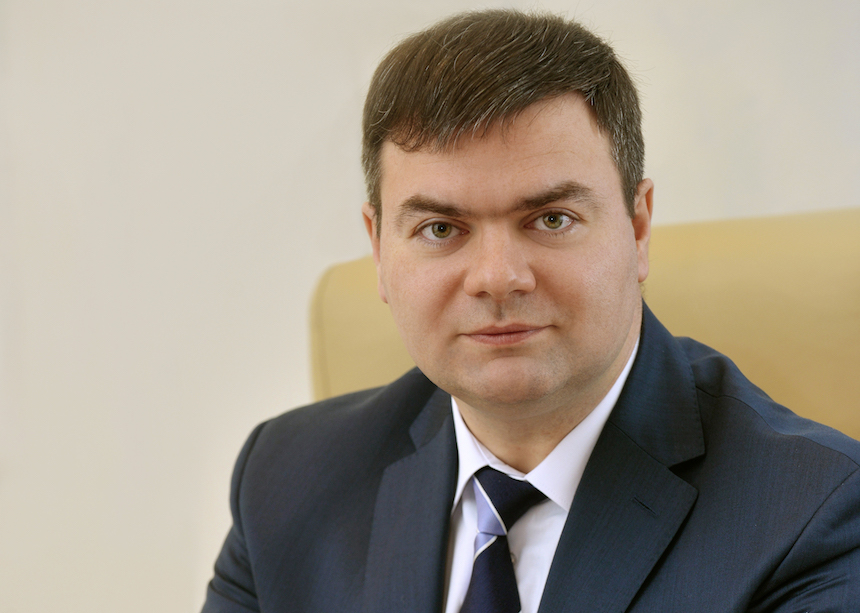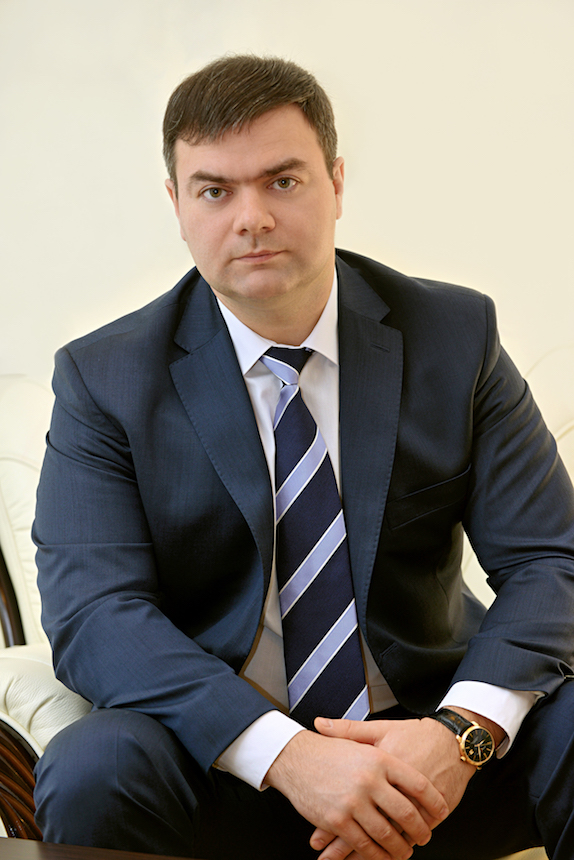The key objective of the National Bank of the Republic of Belarus, today, is maintaining financial stability under the current conditions of considerable external shocks and its main challenges are: high inflation rates, national currency devaluation and the underdeveloped financial sector, including the insurance and security markets.
Taras Nadolny, First Deputy Governor of the National Bank of the Republic of Belarus, spoke to Andrew Wrobel about these challenges and also about the six-month-long denomination process that the Bank launched on July 1 2016, where they cut four zeroes off the large banknotes that Belarusian have been using for two decades.
Foreigners coming to the country, myself included, have always struggled with the Belarusian million notes. Now, since the beginning of July and after the denomination, the notes have lost four zeroes. Such processes took place a couple of decades ago in the CEE region. Why has Belarus only done it now?
The scale of the units and the denomination process is also changing our perception, because here at the National Bank we used to operate in amounts of trillions of roubles. Now, after the change, we are slightly nervous and need to double check the figures.
But speaking seriously, the notes, that we have introduced now, were already printed in the UK, by the way, in 2008. The global financial crisis and the economic climate that followed, which was also felt here in Belarus, made us postpone the process of denomination. We decided to wait for more convenient conditions for our macroeconomic environment and to try to overcome the crisis first.
The main reason behind the denomination was to improve the circulation of money, to streamline accounting and settlements, to maintain the optimal structure of money denominations and to reduce the public expenditure on servicing cash circulation. As you can see, the nature of this process is rather technical — we didn’t expect it to affect purchasing power, the exchange rate or inflation.
Talking about inflation, the main goal of the National Bank is keeping it at the right level. We are constantly looking to manage inflation better.

So what is your inflation target for 2016?
We estimate it will fall to 12 per cent at the end of this year. In my opinion, it is a fair estimate.
Do you think it will go down even further in the following years?
A few weeks ago, we adopted a five-year guideline, until 2020, and according to that document inflation should reach five per cent by the end of the decade. In 2017, it should be nine per cent. If we look at the new approach of our macroeconomic policy, we see a flexible exchange rate and monetary-based targeting. We believe that these two crucial tools will help us achieve our targets.
So we have talked about denomination. Let’s now have a look at the devaluation of the Belarusian currency which has been taking place for over a year now. Some foreign investors complain it’s detrimental to their business. What measures have been taken to tackle that?
Well, the devaluation of the currency has had a number of negative aspects. We have used some key instruments, such as the flexible exchange rate, which helps us reduce the external shocks that the country was forced to face, because of the devaluation of the Russian rouble. Russia is Belarus’ largest trade partner and, as far as I remember, in 2014, when the Russian currency was first devalued, the share of our trade with the country accounted for some 50 per cent. At the beginning of 2015, we changed our monetary policy in all macroeconomic spheres: we set up a continuous double auction, which helps us get a fair value for our currency level.
The other important step, which we took to decrease imbalances in the economy, was taking control of the supply of money. Before that it was one of the drivers of economic growth. We printed some extra money, which increased inflation and internal demand. All that led to a fixed currency devaluation from year to year.
Of course, on the one hand, the devaluation creates good conditions for our exporters because our local products are cheaper in external markets. However, on the other hand, in an environment of higher credit growth — and in our country more than 70 percent of the credit portfolios in the real sector of economy are nominated in foreign currency — any devaluation of the national currency leads to an increased share of problem debt for those enterprises. This also results in an increased cost for servicing foreign and domestic government debt.
So it seems that both the public and the private sectors have been affected. What impact has this had on consumer demand?
The decline in the real income for households is another negative consequence of the devaluation and there has also been a continuing reduction in real income for individuals. In January-April 2016 the real household disposable income has decreased by 6.9 per cent compared to same period of the previous year. That means that, to some extent, the devaluation of the currency has reduced Belarusians’ wealth. However, we estimate that by 2020 the real income will increase by up to 10 per cent compared to 2015.
Briefly coming back to the devaluation; we have an enormous amount of debt, from an earlier time, which we conglomerated at the time of devaluation and we are now refinancing that debt. We are constantly trying to reduce it. The debt repayments are very high but the flexible exchange rate is allowing us to stabilise the situation.
Belarus has an impeccable credit history. In the previous years the country has serviced and settled its debts in full, in a timely manner, even under the conditions of high deficit of the balance of payments’ current account. In this regard, it is safe to say, that as far as the observed balance of payments equilibrium is growing, at present, there will be no problems with debt servicing and repayment either.
Now, I would like to briefly circle back to individuals and consumer loans and mortgages. How are debts handled for individuals?
In 2007 and 2008, we actually benefited from a non-developed financial market. Belarusians didn’t use any financial services apart from simple deposits and loans. A special governmental programme, concerning the development of the financial market, was adopted a few years ago and that was meant to change that, but it hasn’t been implemented yet. Up until now Belarusian use, maybe two or three basic financial instruments.
Last year the National Bank wanted to take over the regulatory functions of the Ministry of Finance, which still has these powers, in order to make the process of developing and improving the financial services available specifically to consumers. The Bank regulates the banking sector, which includes about 95 per cent of all financial services in Belarus. Insurance companies and some small security companies represent less than five per cent of all financial services and are still regulated by the Ministry of Finance.
We weren’t able to transfer the regulatory functions, last year, but we are still working on new arguments to convince the Head of State that shifting regulatory functions to the National Bank is necessary. We are also working on a draft of a new strategy for the development of a financial market in Belarus and we are hoping to adopt it soon.
So when you talk about the development of financial services, which areas do you mean in particular?
The World Bank has helped us to revise the financial market. Their experts said the banking sector was well developed and stable and that the level of banking assets to GDP was satisfactory, however they recommended improvements in two areas: the insurance market and the security market.

So let’s look slightly deeper into the insurance market. How would you like to develop that?
Well, the main idea is to intensify private participation in the insurance market. There are 21 insurers in the country and there is a high concentration of state-owned insurance companies. As a matter of fact we are, to some extent, talking about a conflict of interest between the state, as the owner of these companies, and the regulator which is the Ministry of Finance.
The third area that needs addressing is the equal participation of private and state-owned companies in insurance services. Nowadays, for example, there are some types of obligatory insurance, which can only be delivered by state-owned companies, and we are insisting on equal participation in the market.
Finally, there is the process of automatisation and digitalisation of the insurance market, as well as the communication processes between the company and clients, as this is currently at a very low level.
Do you think there is room for foreign investors in the insurance sector?
The entire financial market still offers good potential for growth. It is stable and it is a good place for a foreign investor to start from. Now, we need to make their presence more comfortable and profitable. It is here that both the National Bank and the Ministry of Finance believe that changes should be made, but it’s a question of the speed of these changes. I believe the experts from the World Bank and the International Monetary Fund (IMF), who are working with us, will help change the attitude of our state officials and will persuade them to make these changes soon.
For the last few years the government has been trying to attract foreign investors to the country but, as far as I know, there is still not as much foreign investment in Belarus as they would want and that they need. Is this so?
Foreign direct investment (FDI) in our country is not as high, nor as significant, as we would like to see it. The latest figures show $1.5 billion, in 2015, and the main share of that amount — $1.1 billion — is reinvestment. Between January and April 2016, we saw an inflow of $1.1 in FDI and up to $1 billion out of the total amount was reinvested income.
Three-five years ago, we kept setting high FDI targets and not achieving them. Now we are not trying to focus on specific FDI figures but rather to create an environment that invites investors to come to Belarus.
The President recently said that it would take at least a $1.5 worth of net foreign direct investment to stimulate economic growth in Belarus in 2016.
When we look at our balance of payment deficit, we require up to the equivalent of $1.5 to cover the balance of payment and these figures correspond to one another. Another issue is the source of the funding. Are these debt-based sources or is it a non-debt source such as FDI. For us, certainly, in order to keep our fixed reserves the solution is naturally more FDI.
However, I believe that whether we attract FDI of $1.5 billion or not is not the major point but rather it is the question of our business environment and how we are trying to improve it.
We were talking about the banking sector and there are quite a few foreign investors there. How do you think they have helped develop the sector?
To a rather significant degree, I think. It’s not only the actual investment, but also the new technologies, the new products, digitalisation and a new banking model. For instance, retail banks stimulated the development of retail banking and introduced a new approach of how to involve individuals and how to teach them to use banking services.
In Belarus there are 26 banks and 21 out of them have foreign capital; in 16 of them the share of foreign capital exceeds 50 per cent. In absolute figures, the share of foreign capital in the banking sector is still less than 20 per cent but even that creates a very positive impact on the development of the sector.
What about the equity or the stock market. It seems as if it doesn’t exist in Belarus, does it?
The Belarusian equity market is constricted and not well-developed, however, we are also taking measures to breathe some fresh air into this sector. There are some financial instruments which allow entities to transfer money capital, from one organisation to another, in order to receive some extra equity capital. The main problem is the mentality of the managers who are waiting for some state support. They are not involved in the standard financial practices perhaps due to a lack of know-how and competence.
Unfortunately, the low interest rate for state financial support has made the managers of state-owned companies uninterested in other financing options. Instead they wait for cheap money from the state and thus extend this generalised attitude to other sources of funding.
The current economic situation in the country that resulted from external shocks and which has caused reductions in GDP, as well as the government’s lending programmes which were a requirement of the IMF, are all finally making these managers start to change their thinking.
I think this situation will, in the medium-term, make the managers of state-owned companies look for alternative financial instruments.
We’re talking about state-owned companies — I know the National Bank has been working with the so called Creditors’ Club. How are the works progressing?
Yes, this club has 106 members — mostly state-owned companies that are facing liquidity problems and/or problems securing credit facilities from banks. The National Bank is now trying to help them refinance and restructure their debts and we have managed to restructure over $1 billion of their credit portfolios.






Add Comment